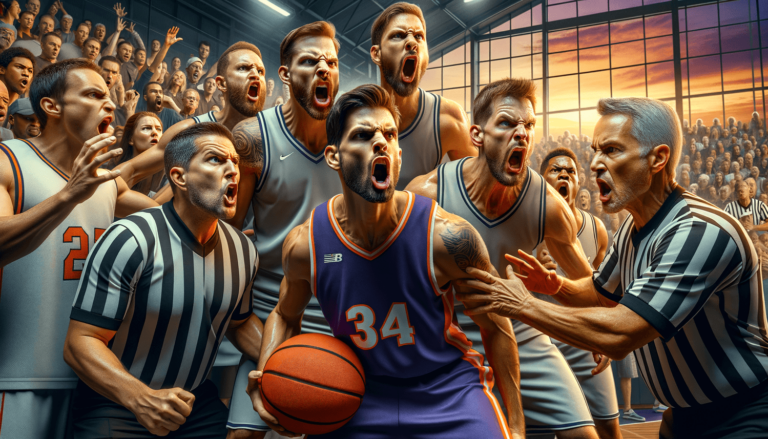
Technical Foul Limit in Basketball: How Many Is Too Many?
Written by: Basketball Universe
Last updated:

Welcome to a thrilling journey through the world of basketball fouls! In this riveting blog post, we will tackle the age-old question: “How many technical fouls are too many?” Whether you’re a seasoned hardwood hero or a rookie eager to learn the rules, this deep dive into the technical foul limit promises to be both educational and entertaining. Stay tuned as we unravel the mystery of this basketball conundrum and unveil the invisible line between a referee’s admonishment and an early trip to the locker room. So, dear readers, lace up your sneakers and let’s explore the heart-pounding excitement that is technical fouls in basketball!
Technical Foul Limit in Basketball: How Many Is Too Many?
In basketball, the technical foul limit depends on the level of play. In the NBA, a player or coach is ejected after receiving two technical fouls in a game, while in college basketball (NCAA), the limit is also two. However, in FIBA and most high school associations, a player or coach is disqualified after receiving only one technical foul.
Technical Fouls: The Art and Science of Frustrating Referees
Before diving deep into the technical foul limit, it’s essential to understand what constitutes a technical foul. In the world of basketball, technical fouls (also known as “techs” or “Ts”) are given to players, coaches, or even entire teams for behavior that violates the standard code of conduct or basketball rules. These actions include unsportsmanlike behavior, disrespecting officials, excessive complaining, inappropriate language, or illegal court entry, among other things.
Leveling the Playing Field: Foul Limit Differences Between Basketball Associations
As mentioned earlier, technical foul limits vary depending on the level of play and the governing body. Let’s take a closer look at how these different basketball associations manage the fascinating world of technical fouls.
NBA: The Birthplace of Tension between Players and Refs
The NBA, the world’s premier professional basketball league, allows its players, coaches, and bench personnel to receive two technical fouls in a game before being ejected. While the NBA is often defined by its superstar players, technical fouls have a storied history of punctuating memorable moments and letting even the most skilled players know who’s in charge.
College Basketball (NCAA): Young Athletes Learning Respectful Conduct
The NCAA, the governing body for American college sports, regulates the actions of student-athletes both on and off the court, aiming to imbue them with a sense of fair play and respect for the rules. Thus, similar to the NBA, the NCAA also enforces a limit of two technical fouls per game. Keep in mind that college basketball regulations can vary by conference, as well.
FIBA: Harmonizing International Basketball Protocol
FIBA, the International Basketball Federation, lays down the groundwork for basketball played at global tournaments and events, such as the Olympics and World Cup. In FIBA, players and coaches are held to higher standards than their NBA and NCAA counterparts, and a single technical foul results in disqualification from the game.
High School Basketball: The Breeding Ground of Budding Talent
Though high school basketball rules may differ based on regional associations, most associations enforce a one-technical-foul limit, similar to FIBA. Early disqualification rules help reinforce proper behavior and maintain the integrity of the game while young players are developing their skills.
Unraveling the Complexity of Technical Fouls in Basketball
Not all technical fouls are created equal. In basketball, technical fouls can be divided into two primary categories: player/coach technical fouls and team technical fouls. It’s important to understand the impact of these different types of fouls on the game itself and the overall foul limits for the players or coaches involved.
Player Technical Fouls: When Emotions Run High
Player technical fouls are assessed when an individual player commits an action that violates the spirit of the game. These fouls count towards a player’s personal foul total, and in situations where a player also incurs personal fouls, those are counted toward the team foul tally. It’s important to remember that reaching the technical foul limit can result in an early departure from the game and may adversely affect the team’s performance.
Coach Technical Fouls: The Thin Line between Passion and Excess
Coaches are not immune to the temptation of crossing the line with referees. Coach technical fouls are given for actions like leaving the coaching box, complaining excessively about calls, or using inappropriate language. Counting toward a coach’s personal technical foul limit, it can be particularly thrilling (or nerve-wracking) for a team’s fans when a coach is ejected from the game due to accumulating too many technical fouls.
Team Technical Fouls: Systems Gone Awry
Unlike player and coach technical fouls, team technical fouls are often a result of procedural infractions like having six players on the court, requesting excessive timeouts, or failing to have a lineup ready before the game. These team fouls do not count toward a player’s or coach’s personal technical foul count. However, the defending team gains a free throw attempt, and possession of the ball passed to them out of bounds, adding an extra layer of strategic depth to this foul type.
How Technical Foul Limitations Impact the Game
Technical fouls not only affect players and coaches involved, but they also have a significant impact on the game. These fouls can tip the scales in favor of the opponent, disrupt team dynamics, and even become powerful psychological weapons.
Points on the Board: Giving Freebies to the Opposing Team
When a player or coach receives a technical foul, the opposing team is granted one free throw attempt, often taken by the team’s best free-throw shooter. The scoring potential provided by the technical foul can be a game-changer, especially in closely contested games.
Teams in Turmoil: Flagrant Fouls and Unsportsmanlike Behavior
Sometimes, accumulating technical fouls may lead coaches or players to step over the line, escalating their behavior to a more dangerous level. When actions like excessive contact or unsportsmanlike conduct start to pose an immediate safety risk, referees are empowered to call a flagrant foul. Two flagrant foul points accumulated during the game will lead to an ejection, furthering the possible consequences of poor behavior. Beyond the potential loss of key players, a team’s morale and spirit can be negatively affected by the presence of technical and flagrant fouls.
The Battle Between Game Flow and Mind Games
Technical fouls can potentially slow down the pace of the game but may contribute to an enthralling struggle of psychological warfare. Some players and coaches use technical fouls as a strategic play, attempting to influence referees’ calls or psych out the opposing team with swaggering bravado. When carefully employed, a strategic technical foul may elicit a reaction or even rattle the opposition, swinging the momentum in favor of the offending team.
Legendary Technical Foul Tales: Stories of Techs in Basketball History
Technical fouls aren’t just about the limits and consequences – they also have a part to play in the lore and legends of the sport. Some of the most memorable moments in basketball history involve these heart-pounding, emotion-charged fouls that have left fans on the edge of their seats.
When Superstars See Red: From Rash to Disqualified
Some of the most respected and accomplished players in the history of the sport have had their fair share of technical fouls. The NBA record for most career technical fouls belongs to the legendary center, Rasheed Wallace, with 317 techs. Not far behind, Karl Malone boasts 332, with both players occasionally earning disqualifications that sent shockwaves through the basketball world. These stories remind fans that even the greatest players can sometimes lose their cool.
A Coach’s Most Iconic Tantrum: Expulsion on a Silver Platter
Perhaps one of the most memorable technical foul ejections in basketball history was when coach Bobby Knight of the Indiana Hoosiers received three technical fouls during a game against the Purdue Boilermakers in 1985. Knight, known for his fiery personality, threw a chair across the court in frustration, igniting a media frenzy and earning himself an unforgettable ejection.
Record-Setting Techs: Making History with Discipline and Fines
The 2001-2002 NBA season saw a record for the most technical fouls in a season, with 1,080 issued throughout the league. The ensuing disciplinary action and fines led to the implementation of the “Respect for the Game” guidelines by the NBA in 2010, aiming to curb excessive complaining and improve the game’s overall image.
Mitigating the Risks: How to Limit Technical Fouls and Stay in the Game
Navigating the minefield of technical fouls in basketball can be tricky, but following a few simple guidelines can help players and coaches minimize techs and maximize their value on the court.
Maintaining Composure: Breathe, Count to 10, and Reset
One of the primary triggers of technical fouls is emotional reaction. Taking a few deep breaths, counting to ten, or finding a mental reset technique can help players and coaches keep their emotions in check and avoid unnecessary techs.
Communication is Key: Talking to Officials Respectfully
As human beings, referees appreciate respect and understanding just as much as anyone else. Addressing referees politely and with empathy may help players and coaches make their case without crossing the line and incurring a technical foul.
A Well-Prepared Team: Staying Informed and Avoiding Procedural Penalties
To prevent team technical fouls, coaches must ensure their teams are well-informed of the basketball rules at all times. Avoiding procedural mistakes like having too many players on the court or mismanaged timeouts can save a
Iconic Technical Foul Showdowns: Moments that Defined the Game
Technical fouls have played a decisive role in many exhilarating basketball matchups throughout history. These iconic confrontations often showcase astonishing skills and the emotional intensity that makes the sport so enthralling. Let’s take a look at some of these unforgettable technical foul moments.
Draymond Green’s Suspension in the 2016 NBA Finals
Perhaps one of the most controversial technical fouls occurred during Game 4 of the 2016 NBA Finals between the Golden State Warriors and the Cleveland Cavaliers. Warriors forward Draymond Green was given a flagrant 1 foul (which also counts as a technical foul) following an altercation with LeBron James. This was Green’s fourth flagrant foul point of the playoffs, resulting in a one-game suspension. His absence from Game 5 is believed to have played a significant role in the Cavalier’s comeback from a 3-1 series deficit to ultimately win the championship.
Shaquille O’Neal and His Technical Foul Rivalry
Hall of Fame center Shaquille O’Neal had numerous on-court rivalries throughout his illustrious career, with some turning into technical foul showdowns. In a 1999 game against rival Alonzo Mourning of the Miami Heat, a fight broke out, resulting in both players being ejected after receiving double technical fouls. However, this wasn’t the first or last time Shaq would clash with another big man, as he also had technical foul-filled confrontations with big men such as Charles Barkley and Brad Miller.
Lessons Learned: What Technical Fouls Teach Us About Basketab]
Technical fouls serve as an important reminder of the emotional intensity and competitive spirit that fuels basketball. Through examining technical fouls, we can glean valuable insights into both the rules of the game and the human aspects that drive the sport.
Respect: A Cornerstone of Good Sportsmanship
At its core, a large portion of technical fouls stem from disrespect – of opponents, teammates, or officials. One of the primary lessons we can learn from technical fouls is the importance of respect at all levels of the game. Embracing and embodying respect helps to ensure that basketball remains an enjoyable, rewarding experience for everyone involved, from players and coaches to fans and officials.
Passion: The Driving Force Behind Great Performances
While it is important to maintain a certain level of decorum during the game, the same passion that can occasionally lead to technical fouls is also responsible for the incredible drive and performance exhibited by many players and coaches. Harnessing this passion and finding ways to channel it constructively can turn a potentially volatile situation into an opportunity for growth and connection – both on and off the court.
Communication: A Key to Success On and Off the Court
Many technical fouls can be avoided simply by enhancing the lines of communication between referees, players, coaches, and teammates. Whether on the court, in the locker room, or in life, effective communication is a vital skill that can help to prevent misunderstandings and needless conflicts. Developing and refining communication skills can lead to more cohesive teams, better relationships with officials, and, ultimately, more success on the court.
Frequently Asked Questions: Technical Fouls Unraveled
Need a quick answer to some common questions about technical fouls? We’ve compiled a list of frequently asked questions to provide you with concise and informative responses. Check out these FAQs to enhance your knowledge of technical fouls and their impact on the game of basketball.
1. What is a technical foul in basketball?
A technical foul is a penalty assessed to players, coaches, or even entire teams for behavior that violates the standard code of conduct or basketball rules, such as unsportsmanlike behavior, disrespecting officials, excessive complaining, inappropriate language, or violating game procedures.
2. How many technical fouls result in ejection from a game?
The number of technical fouls that lead to ejection varies depending on the level of play, with the NBA and NCAA enforcing a limit of two technical fouls, while FIBA and most high school associations enforce a one-foul limit.
3. Can coaches also receive technical fouls?
Yes, coaches can receive technical fouls for actions such as leaving the coaching box, excessive complaining about calls, or using inappropriate language, and they can also be ejected from the game if they accumulate the maximum allowed fouls.
4. Do technical fouls count towards a player’s personal fouls?
Yes, player technical fouls count towards a player’s personal foul total. However, coach and team technical fouls do not count toward a player’s personal foul count.
5. What are the consequences of a technical foul?
When a technical foul is called, the opposing team is awarded one free throw attempt and possession of the ball.
6. What is the difference between a technical foul and a flagrant foul?
A technical foul often refers to unsportsmanlike conduct, while a flagrant foul is called when a player makes excessive or unnecessary contact with an opponent. Flagrant fouls are considered more severe and result in two free throw attempts and possession of the ball.
7. Can a player be ejected for only one flagrant foul?
Yes, if a player receives a Flagrant 2 foul, they are immediately ejected from the game. If a player accumulates two flagrant foul points (either two Flagrant 1 fouls or one Flagrant 2 foul), they are also ejected.
8. What is the record for most technical fouls in an NBA season?
The 2001-2002 NBA season holds the record for most technical fouls, with 1,080 issued throughout the league.
9. Who holds the record for most career technical fouls in the NBA?
Rasheed Wallace holds the NBA record for most career technical fouls, with a total of 317.
10. Is fighting considered a technical foul in basketball?
Fighting in basketball often leads to technical fouls, but it can also result in flagrant fouls, ejections, or suspensions, depending on the severity and nature of the incident.
Featured Posts
- No pillar pages found.





